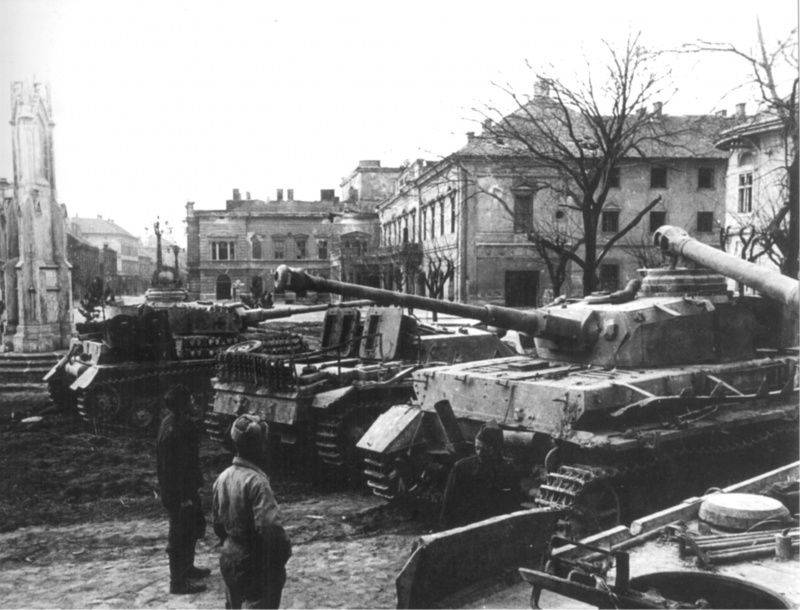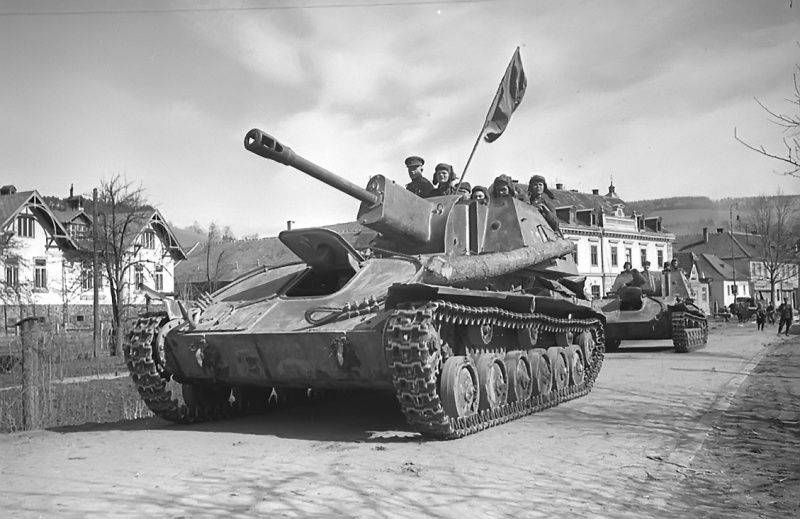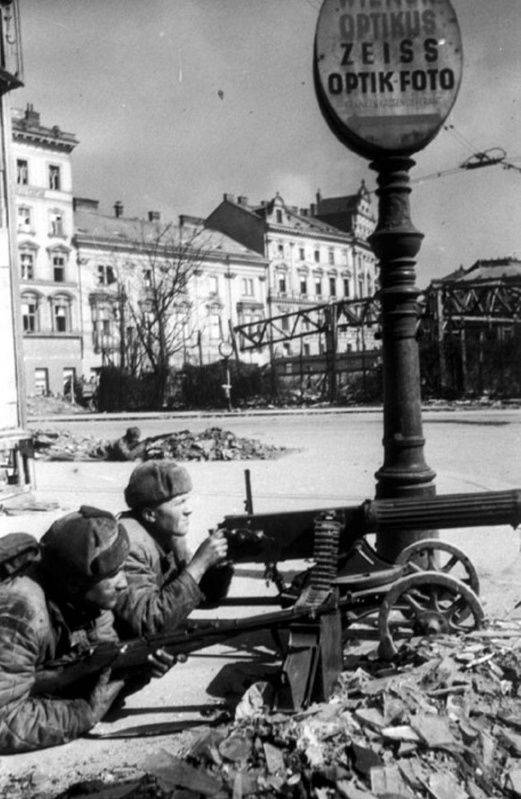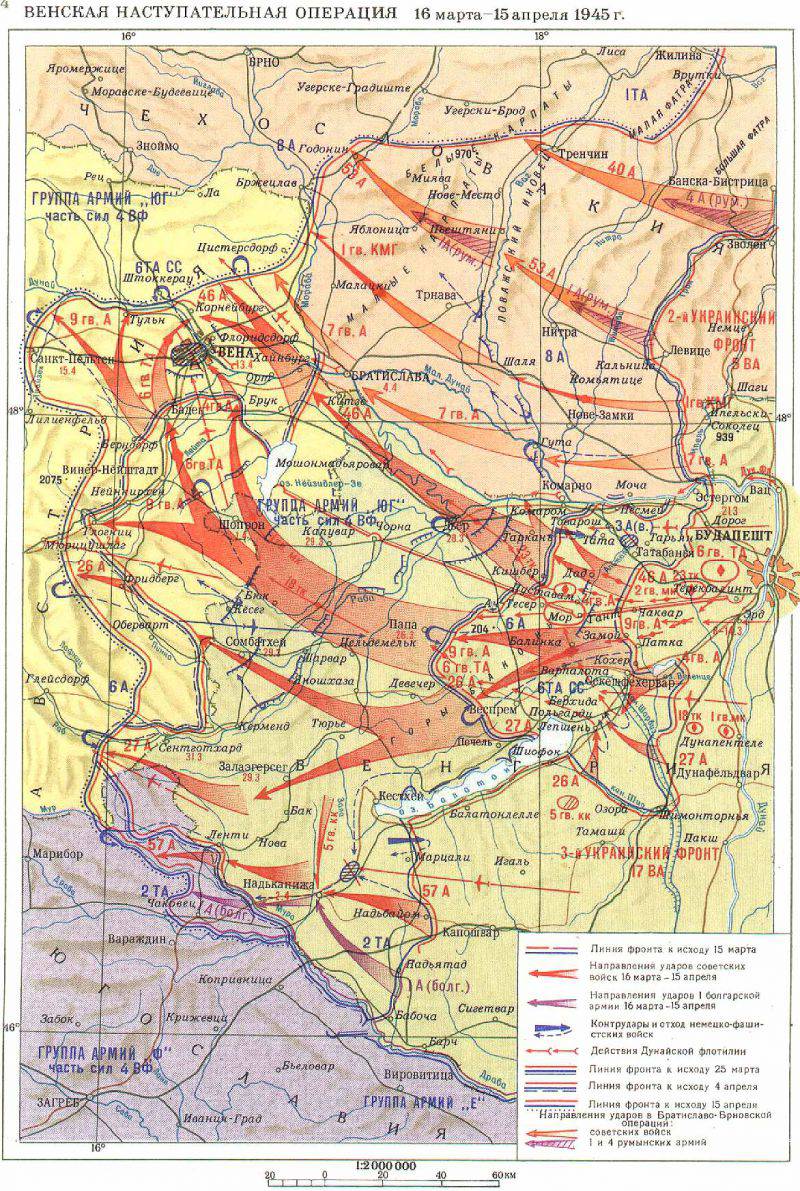The Vienna operation: a breakthrough of the enemy defense and the destruction of the estergomno-commodity group
The onset of the shock group of the 3 of the Ukrainian Front. In the afternoon of 16 March, 1945, after a strong 60-minute artillery preparation, the troops of the 9 Guards Army of Glagolev and the 4 Guards Army of Zakhvatiev launched an offensive. German troops defended stubbornly, made numerous counterattacks. Therefore, on the first day of the offensive, our troops could only penetrate into their defense 3-7 kilometers.
The 4th and 9th guard armies did not take part in the Balaton defensive operation. The 9th Guards Army was fully manned and constituted a serious force. There were 140 people in the companies. The command of the 3rd Ukrainian Front took care of the restoration of forces of the 4th Guards Army. By the beginning of the offensive, the average number of companies was increased to 80 soldiers. If by March 5, 1945, Zakhvatayev’s army had only 22 armored units, then by March 16 it had 122 tank and self-propelled guns. Significant density of artillery was also achieved: in the 9th Guards Army there were 180 guns and mortars and about 9 self-propelled guns per kilometer of the front, and in the 4th Guards Army - 170 guns and mortars and more than 20 tanks and self-propelled guns.
In the attack zone of the Soviet armies, the 4 SS Panzer Corps defended the 3 SS Panzer Division “Dead Head”, the SS Viking 5 Panzer Division, the Hungarian 2 Panzer Division and several separate infantry battalions and special units. On 16 in March the German corps had 35 motorized and infantry battalions, more 430 guns and mortars, 185 tanks and assault guns.
In the current situation, the commander of the 3-th Ukrainian Front, Fyodor Ivanovich Tolbukhin, gave the order not to stop the offensive at night. Glagolev's army was to force the Sharviz Canal and by the end of 17 March, reach the line of Mohr, Balinka, Istimer, and Chor. The army of Zakhvatiev received the task of accelerating the movement, bypassing Szekesfehervar from the southwest and seizing this city as quickly as possible. To ensure the troops of the 4 Guards Army from the possible attacks of the German tank group that operated south of Lake Velenza, and also to prevent the group from moving to the west, one rifle division of the 27 Army was deployed.
In turn, the Supreme Headquarters, which intensified the stalled offensive, in the evening of March 16 handed over to the 3 Ukrainian Front a mobile formation of the 2 Ukrainian Front - the Kravchenko 6 Guards Tank Army. Stalin promised Malinovsky that soon the army would be returned to the 2 of the Ukrainian Front. The bid wanted to create the most favorable conditions for solving the most important task - encirclement and destruction of the main forces of the 6-th SS Panzer Army. The Soviet tank army was supposed to concentrate around Zamaya, Patka by noon on March 17 and go on the offensive on the night from 17 to March 18. The army of Kravchenko was reinforced by a light-artillery brigade, two regiments of an anti-aircraft artillery division, and one engineering battalion.
The nightly operations of the 9th Guards Army did not bring much success. Only at dawn, when the actions of the attack aircraft of the 17th Sudets air force intensified, did Glagolev's army manage to occupy a number of enemy strongpoints during stubborn battles and by the end of the day widened the breakthrough to 30 km along the front and 10 km in depth. I must say that the Soviet aviation played a large role in breaking the enemy defense. The 17th Air Army attacked enemy positions day and night. However, the Germans, using strong defensive lines, actively resisted.
Particularly fierce struggle was for the city of Szekesfehervarar, which was previously the scene of a fierce battle. The city stood in the way of the Soviet group, which struck the northern flank of the German tank army. The SS tank army 6 during the battle of Balaton wedged into the battle formations of the Ukrainian front 3 between the lakes Velence and Balaton. Fearing the encirclement of the advanced forces, which were located in this wedge, the German command tried in every way to hold the city and began to transfer new units to the place of the breakthrough. Take Szekesfehervar 17 March, our troops failed.
March 18 shock group 3-th Ukrainian Front advanced slightly. On this day, the armies of Glagolev and Zakhvatayev moved forward only 6 km and about the same extent expanded the breakthrough. The slow pace of advance in the early days of the operation was due to two factors. First, there was not enough tanks to directly support infantry in the battle formations of rifle divisions of the first echelons of the 4 and 9 of the Guards armies. Secondly, the Germans relied on serious defense and had time to pull up reserves and units from calm sectors of the front. The Germans stubbornly counterattacked and retreated to the pre-prepared rear lines. In addition, 9-I Guards Army attacked in difficult conditions of mountain-wooded areas.
Fearing the encirclement of the SS 6 Panzer Army, in the area south of Szekesfehervar, the German command began a gradual withdrawal of troops defended before the 26 and 27 armies of the 3 Ukrainian Front. These troops moved to the north-west direction, strengthening the defensive orders in the offensive zones of the Glagolev and Zahvatayev armies. In general, this will help Dietrich's tank army avoid encirclement.
On the morning of March 19, the Kravchenko tank army was thrown into battle. The Guards Tank Army inflicted two main attacks on divergent directions: in the western direction, followed by a turn to the south and Veszprem, forming the outer ring of the environment, attacked the Volkoff 9 Guards, which was reinforced by a light artillery brigade and an anti-aircraft artillery regiment; in the southwesterly direction, creating an inner ring of encirclement, the 5 th Guards Tank Corps of Saveliev, advancing by an artillery brigade and an SAU regiment, advanced. In the interval between the two corps, a detachment created from the 9 Guards' Mechanized Corps was moving. The Glagolev guards army followed the tank crews, while the Zakhvatiev army continued to strike south-west. However, the army of Kravchenko met the powerful resistance of the enemy and also failed to immediately break through the enemy defenses, to develop the rapid offensive necessary for encircling the main forces of the SS 6 Panzer Army. In addition, Volkov’s 9 Corps is stuck in the fight with small enemy groups, instead of rushing forward. This allowed the German command to gain the time necessary for the withdrawal of troops.

Captured by Soviet troops in the city of Szekesfehervarvar, German tanks and self-propelled guns, abandoned due to lack of fuel
On March 20, the 27 and 26 armies of Trofimenko and Hagen went on the offensive. Soviet troops were advancing in the direction of Polgardi and Lepshen. After breaking through the enemy defenses, on March 21, the troops of the 27 and 26 armies reached the Polgardi area. At this time, the troops of the main shock group of the front were only 10 km from Lake Balaton, which led to the threat of the complete encirclement of the German tank army. To help 17-th Air Army Sudetz was attracted 18-I Air Army Golovanov, which on the night of March 22 struck a powerful blow to the railway junction Veszprem. At the same time, the bombers and attack aircraft of the 17 Army Sudetz smashed the enemy’s retreating columns on the roads.
By the evening of March 22, the main forces of the SS 6 Panzer Army were almost surrounded in the area south of Szekesfehervar. The German army had only a corridor about 2,5 km wide, which was completely swept by artillery and even large-caliber machine guns. However, the Soviet troops could not close the encirclement ring. The Germans created a dense defense of the four tank and one infantry divisions and under their cover and at the cost of huge losses could avoid the "boiler".
Thus, the troops of the 3 of the Ukrainian Front could not surround the Székesfehérvár group of the enemy. A negative role in this failure was played: the slow development of the offensive in the early days of the battle, the lack of ammunition for artillery, the lack of tanks for direct support of infantry and the lack of superiority in armored vehicles over the enemy in the direction of the main attack.
However, the main task was solved. Soviet armies broke through the defenses of the enemy and quickly developed success. German troops were defeated and retreated, unable to gain a foothold on the intermediate lines of defense. March 22 Soviet troops captured Szekesfehervarr, which was turned into ruins during the fierce battles, and Vesnprem was taken on March 23. Our troops overcame the mountains of Bakony, and by 25 March, advancing to 40-80 km, took the city of More, Varpalota, reaching the Pope-Devecher-Pechel line.
The attack of the shock group of the 2 of the Ukrainian Front
March 17 launched an offensive strike group 2-th Ukrainian Front. The 46 Army had significant strengths: 10 and 18 Guards, 23, 68 and 75 Rifle and 2 Guards Mechanized Corps, as well as the 83 Brigade of the Marine Corps. It was reinforced by three breakthrough artillery divisions, one anti-aircraft artillery division, two separate anti-tank brigades, and three guards mortar regiments. As a result, 12 rifle divisions, 2686 guns and mortars of all calibers, 165 tanks and self-propelled artillery units (about a hundred tanks and self-propelled guns were part of the 2 Guards Mechanized Corps) were in the shock grouping of the front. Before the front of the 46 Army, 7 infantry divisions and part of one enemy tank division defended themselves. The enemy had 619 guns and mortars, 85 tanks and SPG.
In the first echelon of the strike force at the front of 12 km, the 75th and 68th rifle corps advanced, in the second echelon the 18th guards rifle and 2nd guards mechanized corps. About 1 guns and mortars, about 140-12 tanks and self-propelled guns per 13 km of the breakthrough site. On the right flank of the army, an auxiliary strike was delivered by the 10th Guards and 23rd Rifle Corps, which in cooperation with the 2nd Guards Mechanized Corps and the Danube flotilla, were to surround and destroy the enemy troops in the area of Esztergom. From the Danube Flotilla, 46 different boats, a separate air squadron, part of the 83rd Marine Corps and the coast escort took part in the operation.
The main blow was struck on the left wing of Petrushevsky's 46 Army. True, on this day only advanced battalions launched an offensive. Their success predetermined the successful offensive of the whole army. The advanced units of the 46 Army attacked the enemy on the evening of March 16. After a short but powerful artillery raid, the forward battalions rushed to assault enemy positions. With a swift jerk, they captured the advanced fortifications and wedged themselves into the enemy’s defensive orders, in some sectors up to 1 kilometers. With the dawn, our advanced battalions continued the offensive and captured the first position of the main line of enemy defenses. The advanced battalion of the 52 Rifle Division, which advanced to 3 km and captured the Kehanyash strong point, achieved the greatest success.
March 17 advanced units developed success and wedged into the enemy defensive orders by 10 km, reaching the line of the Altal River, that is, to the second line of defense of the German troops. In the center and on the right flank of the 46 Army, the advance of the troops of the 10 Guards and the 23 Infantry Corps did not immediately bring success. Here our troops penetrated the enemy's defense only 1 km. In general, the successful development of the attack of the army of Petrushevsky bound the German troops in this sector and did not allow them to be transferred to the direction of the attack of the assault group of the 3 of the Ukrainian Front.
In the evening of March 17 at the headquarters of the 46 Army, at a meeting with the Malinowski front, it was decided to continue the offensive on the left flank of the army, where the greatest success was achieved and to introduce into the breakthrough the 2 Guards Mechanized Corps of Siridov. March 18, the main forces of the Petrushevsky army went over to the general offensive. Our troops crossed the river Altal. The Germans fought hard. Using a well-prepared mountainous-wooded area, the enemy fired heavily and counterattacked with the support of groups of tanks and aircraft. Especially fierce battles were in the offensive zone of the 75 Infantry Corps of General A. 3. Akimenko.
However, our troops were able to penetrate into the second lane of the German defense, creating favorable conditions for the introduction of a mobile unit into the battle. German air reconnaissance detected the advancement of the Soviet 2 Guards Mechanized Corps and enemy bombers struck a forest where our armored vehicles had previously been located. However, the mechanized corps managed to move to a new area and the blow fell on an empty space. Early in the morning of March 19, after an artillery strike, the Sviridov mechanized corps entered the breakthrough. The 5 th assault air corps of the 5 th Air Army provided great support to its attack. The offensive of the Soviet tankers was successful, already in 9 hours of the morning the corps fought for the cities of Tovarosh and Tata. By the end of March 19, the army of Petrushevsky advanced deep into 30 km. By 20 March, our troops advanced westward 40 kilometers. The tactical zone of the enemy’s defense was broken, and part of the three divisions of the German-Hungarian group were defeated.

Soviet SU-76M self-propelled artillery mounts in Vienna
Destruction of the estergomsky commodity group
On March 20, the army of Petrushevsky, developing an advance northward on Tovarosh, advanced to the Danube. As a result, the estergom-commodity group of the enemy was pressed into the river as part of four divisions. Meanwhile, the Soviet Danube flotilla made its way into the depths of the enemy defense, passed under the destroyed Esztergomsky bridge and landed an airborne detachment on the right bank of the Danube, in the Tata area. Our paratroopers attacked the enemy’s rear and cut off the enemy’s escape routes to the west. The Soviet marines, with the support of naval artillery, fought off fierce attacks for more than three days and on March 22 joined up with the Sviridov tank crews. At the same time, the 5 airborne Amia Goryunova continued to operate actively.
Part of the enemy's four divisions got into the "boiler": the 96-I and 711-I German infantry divisions, the 23-I Hungarian infantry division, the Cavalry division "Fegelein" and the 92-I motorized brigade. In total, more than 20 thousand soldiers and officers, a lot of equipment and a large number of various military equipment were surrounded.
The German command, in order to prevent the breakthrough of our troops in the Gyor direction and save the surrounded group in the region of Esztergom, transferred additional forces to the area of attack of the Petrushevsky army. Part of two tank divisions and one infantry division, which were removed from the area south of Lake Velenza, as well as a brigade of assault guns, advanced to this direction. 21-25 in March German troops made continuous counterattacks, trying to close the gap, throw away the Soviet troops and save the estergomno-commodity group. Up to 130 of enemy tanks and SPGs took part in these attacks. However, these attacks were not successful, although they slowed down the pace of movement of our troops.
The situation was especially difficult in the evening of March 21, a large group of the enemy pressed down parts of the 18 Guards Rifle Corps. Petrushevsky put forward an 109 Infantry Division from the reserve of the army, which had to go into battle directly from the march. In addition, the 53 Infantry Division was transferred to the threatened sector, which was transferred to the 46 Army from the front reserve. It was reinforced by an anti-tank artillery brigade. As a result, the attack of the enemy was repelled.
In the meantime, the Esztergom faction was destroyed. The Soviet command took all measures to prevent the enemy from breaking through. A large role in this operation was played by Soviet aviation, which, day and night, observed the encircled grouping and did not allow the enemy to cross to the north bank of the Danube. Continuing the offensive in the Gyor direction, part of the forces of the 46 Army fought with enemy troops surrounded. The first attacks of the Soviet troops, who tried to dismember the estergom group, were repulsed by the enemy. But in the following days the surrounded group was destroyed. The city of Esztergom - a major communications hub and a powerful enemy stronghold, was taken. Our troops cleared from the Nazis the south bank of the Danube from Esztergom to Almassi.
By March 25, Soviet troops made a breach with a depth of 45 km and a width along the front of 100 km. To enhance the strike power of the 2 of the Ukrainian Front, he was transferred from the 3 of the Ukrainian Front to the 23-th Panzer Corps of Akhmanov, who became part of the 46-th Army of Petrushevsky.
Results of the first stage of the operation
Thus, from 16 to 25 in March 1945, our troops broke through the German-Hungarian defense between the Danube and Lake Balaton, overcame the mountains Vertes and Bakony, advanced to a depth of 100 - 120 km, creating conditions for the development of an offensive on Vienna. The Soviet troops eliminated the penetration of the 6 th SS Panzer Army into the location of the 3 Ukrainian Front at the lake. Balaton and destroyed the estergom-commodity grouping of the enemy. The troops of the two Ukrainian fronts reached the line of Komar - Kisber - Papa - Devecher - Pechel. German-Hungarian troops suffered a heavy defeat and began to retreat to the line of defense along the border of Austria and Hungary.

Soviet machine-gunners lead a street fight in the central part of the city of Vienna
To be continued ...

Information